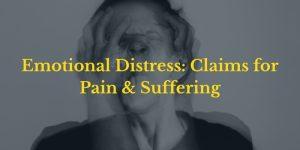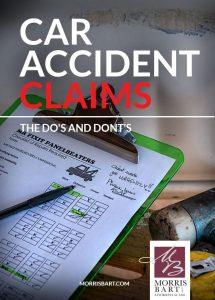
After a car accident, most people focus on visible injuries like bruises, broken bones, and medical bills. But many accident victims also suffer from emotional distress, a less visible but equally serious consequence of a collision. Emotional trauma after a car accident can be life-altering, affecting your ability to work, drive, or sleep.
If you find yourself avoiding driving, reliving the crash, struggling with anxiety, or feeling unusually irritable or withdrawn, you may be experiencing symptoms of emotional distress.
Understanding the signs of emotional trauma is crucial, not just for your mental health, but also because emotional suffering can be included in your personal injury claim. In this blog, we’ll cover how to recognize emotional distress after a car accident and explain how you may be able to recover compensation for your mental and emotional injuries.
What Is Emotional Distress in a Personal Injury Case?
Emotional distress in a personal injury case refers to the mental and emotional suffering a person endures after a traumatic event, such as a car accident. This can include anxiety, depression, fear, insomnia, and even post-traumatic stress disorder (PTSD). In legal terms, emotional distress is considered a form of non-economic damages—losses that don’t come with receipts but still significantly affect your daily life and well-being.
While the law may separate terms like pain and suffering, mental anguish, or psychological trauma, they are often grouped together under the broader category of emotional distress. These damages recognize the very real impact that mental and emotional injuries can have on your recovery and your ability to return to normal life.
Because these emotional damages were caused by the accident and not something you would have experienced otherwise, you may be entitled to recover these damages through a personal injury lawsuit or insurance claim.
5 Common Signs of Emotional Distress After an Accident
Emotional distress can manifest in many different ways, and every person responds to trauma differently. Not sure if what you’re feeling qualifies as emotional distress after a car accident? Here are five common signs to watch for:
- Persistent anxiety, nervousness, or a sense of dread
- Nightmares or difficulty falling or staying asleep
- Panic attacks triggered by reminders of the crash
- Physical symptoms like headaches, fatigue, or stomach issues caused by stress
- Loss of interest in daily activities, relationships, or things you once enjoyed
If you’re experiencing any of these symptoms, or if your preexisting mental health concerns have worsened since the accident, it’s important to talk to a doctor. This could be your primary care physician, a mental health professional, or the doctor treating your accident-related injuries. Having these symptoms documented in your medical records is crucial if you plan to pursue compensation for emotional distress, as insurance companies and at-fault drivers may challenge these types of claims.
For a free legal consultation, call 800-537-8185
Can You Sue for Emotional Distress After an Accident?
Yes, you can sue for emotional distress after a car accident. In nearly every state, emotional suffering is considered part of your non-economic damages in a personal injury claim, but the process and requirements vary depending on your state’s laws.
Because emotional distress is less visible than physical injuries, it often requires more evidence and documentation to support your claim. If you’re considering suing for emotional distress, here are five key factors you’ll likely need to prove:
1. Duration of Emotional Distress
To pursue a successful emotional distress claim, the emotional effects must extend beyond the immediate aftermath of the accident. While it’s normal to feel shaken or anxious shortly after a crash, ongoing symptoms, such as anxiety, depression, or fear of driving, may qualify as emotional distress under the law.
2. Severity of Your Symptoms
Courts will also consider the intensity of your emotional suffering. If you’re experiencing debilitating symptoms, such as panic attacks, severe anxiety, or physical manifestations like chronic headaches or gastrointestinal issues, this can strengthen your case for emotional damages.
3. Severity of the Accident
More serious or traumatic accidents are more likely to result in emotional distress. A high-speed collision or an accident involving serious injuries or fatalities may be more likely to lead to lasting psychological trauma than a minor fender bender.
4. Clear Fault by Another Party
To recover compensation, you’ll need to show that another party’s negligence caused the accident and that your emotional distress is a direct result. Establishing liability is essential to linking your suffering to the incident and holding the at-fault driver responsible.
5. Medical Documentation and Mental Health Treatment
Perhaps the most important part of proving emotional distress is documentation from a licensed healthcare provider. Testimony or written evaluations from a doctor, psychologist, or therapist can help validate your experience. Records showing that you sought treatment, whether counseling, therapy, or prescribed medication, can significantly bolster your claim.
How Is Emotional Distress Different from IIED and NIED?
Emotional distress is often included as part of a personal injury claim, especially when it occurs alongside physical injuries. However, it’s different from the standalone legal claims like Intentional Infliction of Emotional Distress (IIED) and Negligent Infliction of Emotional Distress (NIED), which are typically pursued when no physical injury is present.
What Are IIED and NIED?
- Intentional Infliction of Emotional Distress (IIED) applies when someone deliberately causes another person severe emotional harm through outrageous or extreme conduct.
- Negligent Infliction of Emotional Distress (NIED) applies when someone’s careless behavior causes another person emotional harm, even if no physical injury occurs.
Both IIED and NIED are rarely used and require a much higher burden of proof than emotional distress claimed as part of a personal injury case. Courts typically require clear and convincing evidence of egregious conduct, which can be difficult to prove.
In contrast, emotional distress in a car accident case is considered part of your non-economic damages and does not require showing extreme behavior. Instead, your attorney can support your claim with medical records, mental health evaluations, and expert testimony that demonstrate how the accident has affected your emotional well-being. This evidence is used to calculate a fair value for your emotional damages and pursue compensation as part of your overall injury claim.
Click to contact our personal injury lawyers today
What Are the Time Limits for Filing Emotional Distress Claims?
If you’re considering seeking compensation for emotional distress after a car accident, it’s essential to act quickly. Each state sets a legal deadline—called the statute of limitations—for filing a personal injury lawsuit. This includes claims for emotional damage. In many states, this time limit is between one and three years from the date of the accident. For example:
- Alabama: 2 years (Ala. Code § 6-2-38)
- Arkansas: 3 years (Ark. Code Ann. § 16-56-105)
- Louisiana: 2 years (La. Civ. Code Art. 3492)
- Mississippi: 3 years (Miss. Code Ann. § 15-1-49)
If you miss the deadline, you may lose your right to file a lawsuit or recover compensation, regardless of how strong your case may be.
Speak With an Attorney About Your Emotional Distress Claim
Once your physical injuries have stabilized, it’s critical to speak with a personal injury attorney as soon as possible, especially if you’re experiencing signs of emotional distress. Many accident victims delay seeking help for their emotional suffering, assuming it’s not “serious enough” to be part of a claim. But emotional trauma can have a lasting impact on your health, relationships, and ability to function day-to-day, and the law may entitle you to compensation for that suffering.
An experienced attorney can help you determine whether your emotional distress qualifies as part of a personal injury claim, explain your legal rights, and guide you through the process of pursuing financial recovery. They’ll also ensure your case is filed before the statute of limitations expires, which is crucial to preserving your right to seek damages. In many cases, your lawyer will gather medical documentation, consult with healthcare providers, and calculate an appropriate value for your emotional damages as part of your overall settlement demand.
Free Case Evaluation—Find Out If You Qualify for Compensation
With convenient office locations throughout Louisiana, Mississippi, Alabama, and Arkansas, the Morris Bart law firm is here to serve clients across the Gulf South—so you don’t have to face the legal system alone. An experienced accident attorney at Morris Bart can review your case, answer your questions, explain your legal rights, and assess the strength of your emotional distress or personal injury claim. There’s no obligation to move forward, and your initial consultation is completely free.
Fill out our free case evaluation form or call 1-800-537-8185 today to connect with a Morris Bart personal injury lawyer near you.
Questions?Call 800-537-8185
to find a Morris Bart office near you.





